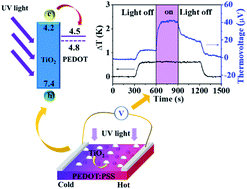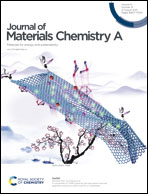Photo-enhanced Seebeck effect of a highly conductive thermoelectric material†
Abstract
Both a high Seebeck coefficient and high conductivity are important for thermoelectric materials that can be used to directly convert heat into electricity. Although light exposure can affect the Seebeck coefficient of some inorganic or organic materials with low conductivity, it cannot enhance the Seebeck coefficient of thermoelectric materials with high conductivity, and thus it has no practical significance. Here, we report the photo-enhanced Seebeck effect on flexible and highly conductive composites of poly(3,4-ethylenedioxythiophene):poly(styrenesulfonate) (PEDOT:PSS) with TiO2 nanoparticles. When a composite of PEDOT:PSS with dispersed TiO2 nanoparticles of 66.9 wt% loading is exposed to UV light, its Seebeck coefficient can be enhanced from 23.5 to 94.3 μV K−1, and the UV exposure of a double-layer structure of PEDOT:PSS and TiO2 nanoparticles can enhance its power factor from 159 to 356 μW m−1 K−2. We propose that the enhancement in the Seebeck coefficient arises from the UV light-induced electron excitation from the valence band to the conduction band of TiO2 and the subsequent electron transfer from the conduction band of TiO2 into PEDOT:PSS. This can partially dedope PEDOT:PSS and thus increase the Seebeck coefficient, and the dedoping of PEDOT:PSS can be readily tuned by controlling the light intensity.



 Please wait while we load your content...
Please wait while we load your content...